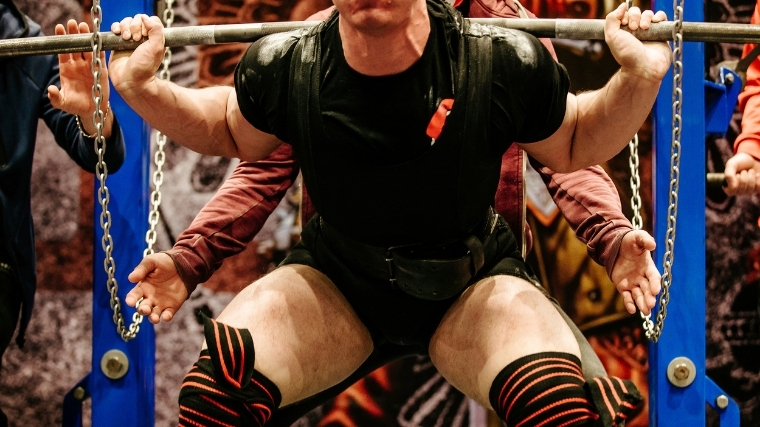It’s crucial to leave no stone unturned when you’re chasing maximal gains. This may mean scouring new training programs, periodization methods, or exercises to bolster your current regimen. Or, it can be something that’s been sitting right in front of you the whole time.
Most training programs tend to put the focus purely on the concentric side of things — the actual lifting of your barbell, dumbbell, kettlebell, or whatever you’re working with.

However, eccentric (or the lowering portion) repetitions have a ton of unique training applications that often go untapped. Whether it be due to the perceived difficulty, unfamiliar sensations, or just plain lack of information, the negative-only repetition can be a huge boost to your progress.
Here’s how you can use the negative repetition for positive gains.
Negative Repetitions Explained
- What Are Negative Repetitions?
- Types of Negative Repetition Training
- Benefits of Negative Repetitions
- How to Program Negative Repetitions
- Examples of Negative Repetition Training
- Frequently Asked Questions
What Are Negative Repetitions?
Each repetition of an exercise has three components. The concentric is where your muscle is shortening while producing force – think the lifting portion of a biceps curl here.
The eccentric component of the repetition is where your muscle is lengthening while resisting the load – this would be the lowering portion of the biceps curl.

You can also spice in an isometric component where you are paused, producing force without movement – but this is a bit more uncommon in muscle building routines.
Negative repetition training will place a greater emphasis or fully prioritize the eccentric part of the exercise.
Types of Negative Repetition Training
There are a few main types of negative repetition training that you can implement into your programs. Either specific eccentric control using tempo, or, if you have a spotter, complete eccentric overload.
Eccentric Control (Tempo)
Tempo is a training technique that assigns specific lengths of time to spend during each phase of a repetition (concentric, isometric, or eccentric).
If you’re looking to extend the challenge of any particular exercise, intentionally assigning eccentric tempo to control your weight through the lengthening portion can be a great option.

Not only will it help generate fatigue with less load due to each repetition taking longer to complete, it will also help you remain in as much control as possible for skilled execution of each repetition.
While eccentric control can be highly beneficial, don’t go overboard with it. The slower you move the weight, the less load you can ultimately train with. Use an eccentric tempo of 2-4 seconds on the descent for maximal results.
Eccentric Overload
Eccentric overload training places more emphasis on the negative side of the repetition than the concentric, and provides some physical assistance to help you lift a weight that would otherwise be too heavy for you.
This means using a spotter to pull on the bar for you, or relying on dynamic support from a resistance band. You can also lower a one-armed exercise normally and then lift it with assistance from your other arm in some cases.

Research indicates that you’re much stronger at resisting a weight than you are lifting it, so playing to your strengths can help you improve your performance in the right contexts. (1)
Generate as much stimulus as possible by performing eccentric overload as a main or finishing component of your workout.
Benefits of Negative Repetitions
Negative repetitions aren’t just a gimmicky new way to perform the same old exercises. By emphasizing the negative you can help boost your muscle gain, build strength, and help promote resilience to future workouts.
Potentially More Muscle Gain
Lifting weights in general will result in muscle gain, although the meat and potatoes of your program will likely always place a greater focus on standard rep execution with a balanced concentric and eccentric.
WIth that in mind, there is research to support the potential superiority of negative repetition (or eccentric-only) training to grow muscle when compared to more standard styles. (2)
Although it can be a bit more involved to set up and execute, spending a bit of time in a periodized program emphasizing the negative can definitely benefit your muscle gain goals.
Massively Increased Strength
Negative repetitions have a great carryover to strength from a pure loading perspective. Since you are stronger during the negative — and will therefore be using more weight to generate your stimulus — the muscle, connective tissue, and likely some coordination aspects of your lifting will all benefit from the added intensity.
Using negative repetitions to truly overload the eccentric should be performed with a spotter where possible to stay as safe as you can.
Improved Resilience
The negative portion of muscle contraction is often associated with increased muscle damage (or at the very least delayed onset muscle soreness). (3)
However, there is a repeated bout effect when it comes to training, where each subsequent workout is easier to recover from than the last, as long as you’re consistent.

So, splicing in exercises that heavily emphasize the negative portion (like Romanian deadlifts) can help you become more resilient to future training sessions. (4)
How to Program Negative Repetitions
Programming negative repetitions doesn’t have to completely monopolize your entire training program to create gains. You can also use them as a finisher, to help develop skill with intentional tempo training, or write a negative-focused training block.
As Finishers
Workout finishers using negative repetitions can be extremely powerful at generating the most amount of mechanical tension possible, bringing you as close to failure or beyond.
If you want to make heavy eccentrics the capstone to your session, complete a set to concentric failure (no longer being able to lift the weight on your own) and grab a spotter to help you raise it back to the top. Slowly lower the weight under control for a few extra repetitions before enlisting the help of your spotter to return it to the starting position.
Similarly, you can perform this same finisher style using one limb on the negative portion of the lift and both on the lifting portion. Think of a seated hamstring curl as an example here – use both legs to curl the legs and only one to slowly lower the weight back down.
For Negative-Focused Training Blocks
You can also create a series of workouts that place an entire training session on the negative repetition train. You likely won’t need very many exercises — probably only one per muscle group.
[Read More: The Most Effective Workout Splits, Created by Our Experts]
Perform 2-3 sets of each exercise with a focus on the negative part of the repetition before moving onto the next muscle of the day.
Tempo Exercises
Tempo exercises are a much gentler way to implement negative repetition training. Tempo work pulls you a bit further back from maximal muscle or strength stimulus and more towards skill development or progressive overload.
Adding extra tempo to any exercise can be as easy as starting with 2-4 seconds on the eccentric portion and slowly pulling that number back down over the course of a training block.
As your tempo gradually returns to a more standard style of lifting, you can increase the loads you’re working with as well.
Examples of Negative Repetitions
The negative-repetition-emphasis style of training is particularly effective with exercises that are possible to execute with a partner, machines, or those that are major movement patterns.
4-Second Eccentric
Using the eccentric control method of negative repetitions is a great way to bolster your skill, mobility, and stability through unilateral exercises. They will already be challenging by placing a greater emphasis on one limb, but by adding eccentric tempo you can make them even more beneficial.
Try performing a Bulgarian split squat with a 4-second eccentric tempo to milk the benefits out of the negative portion of the repetition.
Partner-Assisted Overload
Partner overload is a method of negative repetition that enlists the help of a friend to raise the weight back to the starting position. This is because the load selected will be too heavy for you to complete concentrically on your own.

Try this with an EZ-Bar preacher curl. Slowly lower the bar under control to emphasize the negative, then allow your partner to assist you in curling it back up.
Manual Overload
Manual overload sounds confusing, but it’s really quite simple. On any single-arm or leg exercise, assist your working limb with your non-working limb during the concentric portion.
For example, you can slowly lower a dumbbell during a heavy concentration curl and then apply some pressure with your other arm to the concentric.
The Positive Side of Negatives
Negative repetitions are a sneaky way to boost your training results across a number of different adaptations. Skill, strength, and muscle gain all benefit from various degrees of negative repetition training – from simply controlling the eccentric to all-out sets using a spotter.
A muscle tends to be stronger in the negative portion of the repetition; use this to your advantage to generate as much stimulus as possible. Smatterings of negative repetition training can remain long-term from implementing tempo, completely smashing a muscle group as a finisher, or being part of “controlled chaos” in a periodized program.
In any respect, negative repetitions are an often forgotten route to unclaimed gains – get started today by “lowering” yourself to new heights!
FAQs
If you’ve still got some lingering questions about negative reps, look no further. We’ve got answers.
How Often Should I Use Negative Repetitions?
Negative repetitions are a great training tool, but like anything, they suffer from diminishing returns. If you use them continuously in your training, the overall impact they make will likely start to fade.
With this in mind, implement them for a finisher, or even an emphasized training block (2-4 weeks) before rotating them back out.
Are Negative Repetitions Safe?
Negative repetitions are safe. While all forms of exercise are not without some form of risk, the idea behind negative repetitions is to not go overboard with the loading. While you should be stronger in the negative than in the concentric, fatigue accumulation can increase your risk of losing position no matter how you’re training.
Use a spotter and always keep a solid repetition in the tank and you’ll be just as safe as any other form of training.
What Exercises Are Best for Negative Repetition Training?
Any exercise that can be safely overloaded beyond what you can lift in the concentric on your own. Machines and free weights can both be used here, with a spotter being particularly important for free weights.
If you’re looking to simply employ eccentric tempo as a form of negative repetition training – nearly all exercises can be used.
References
1. Herzog W. (2018). Why are muscles strong, and why do they require little energy in eccentric action?. Journal of sport and health science, 7(3), 255–264.
2. Schoenfeld, B. J., Ogborn, D. I., Vigotsky, A. D., Franchi, M. V., & Krieger, J. W. (2017). Hypertrophic Effects of Concentric vs. Eccentric Muscle Actions: A Systematic Review and Meta-analysis. Journal of strength and conditioning research, 31(9), 2599–2608.
3. Proske, U., & Morgan, D. L. (2001). Muscle damage from eccentric exercise: mechanism, mechanical signs, adaptation and clinical applications. The Journal of physiology, 537(Pt 2), 333–345.
4. Hyldahl, R. D., Chen, T. C., & Nosaka, K. (2017). Mechanisms and Mediators of the Skeletal Muscle Repeated Bout Effect. Exercise and sport sciences reviews, 45(1), 24–33.
Featured Image: Fotokvadrat / Shutterstock